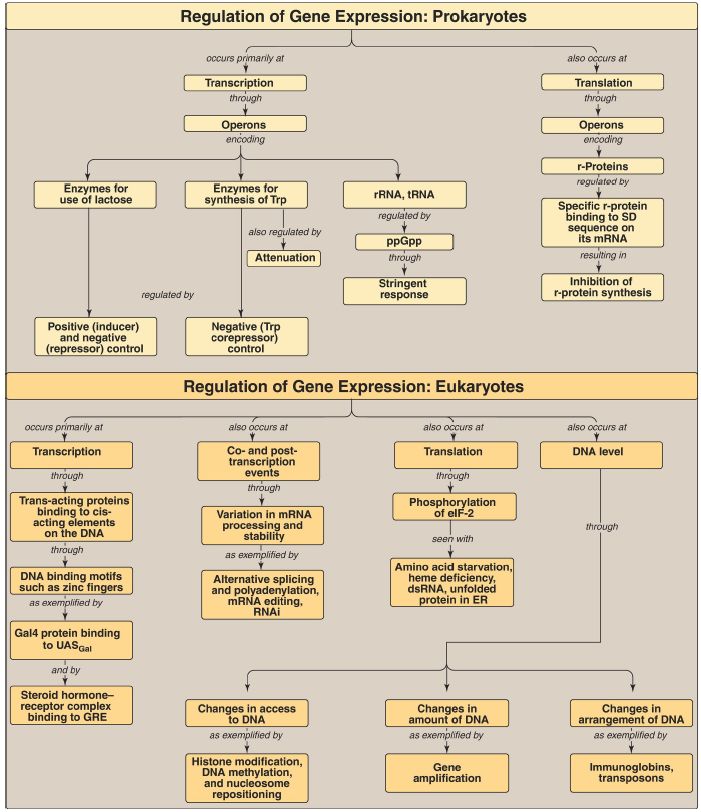
Regulation of Gene Expression
 المؤلف:
Denise R. Ferrier
المؤلف:
Denise R. Ferrier
 المصدر:
Lippincott Illustrated Reviews: Biochemistry
المصدر:
Lippincott Illustrated Reviews: Biochemistry
 الجزء والصفحة:
الجزء والصفحة:
 31-12-2021
31-12-2021
 1631
1631
Regulation of Gene Expression
Gene expression results in the production of a functional gene product (either RNA or protein) through the processes of transcription and translation (Fig. 1).
Genes can be either constitutive (always expressed, housekeeping genes) or regulated (expressed only under certain conditions in all cells or in a subset of cells). The ability to appropriately induce (positively regulate) or repress (negatively regulate) genes is essential in all organisms. Regulation of gene expression occurs primarily at transcription in both prokaryotes and eukaryotes and is mediated through trans-acting proteins binding to cis-acting regulatory DNA elements.
In eukaryotes, regulation also occurs through DNA modifications and through posttranscriptional and posttranslational processing. In prokaryotes, such as Escherichia coli, the coordinate regulation of genes whose protein products are required for a particular process is achieved through operons (groups of genes sequentially arranged on the chromosome along with the regulatory elements that determine their transcription). The lac operon contains the Z, Y, and A structural genes, the protein products of which are needed for the catabolism of lactose. It is subject to negative and positive regulation.
When glucose is available, the operon is repressed by the binding of the repressor protein (the product of the lacI gene) to the operator, thus preventing transcription. When only lactose is present, the operon is induced by an isomer of lactose (allolactose) that binds the repressor protein, preventing it from binding to the operator. In addition, cyclic adenosine monophosphate (cAMP) binds the catabolite activator protein (CAP), and the complex binds the DNA at the CAP site. This increases promoter efficiency and results in the expression of the structural genes through the production of a polycistronic messenger RNA (mRNA). When both glucose and lactose are present, glucose prevents formation of cAMP, and transcription of these genes is negligible. The trp operon contains genes needed for the synthesis of tryptophan (Trp), and, like the lac operon, it is regulated by negative control. Unlike the lac operon, it is also regulated by attenuation, in which mRNA synthesis that escaped repression by Trp is terminated before completion. Transcription of ribosomal RNA and transfer RNA is selectively inhibited in prokaryotes by the stringent response to amino acid starvation. Translation is also a site of prokaryotic gene regulation: Excess ribosomal proteins bind the Shine-Dalgarno sequence on their own polycistronic mRNA, preventing ribosomes from binding.
Gene regulation is more complex in eukaryotes. Operons are not present, but coordinate regulation of the transcription of genes located on different chromosomes can be achieved through the binding of trans-acting proteins to cis-acting elements as seen in the galactose circuit in unicellular yeast. In multicellular organisms, hormones can cause coordinated regulation, either through the binding of the hormone receptor–hormone complex to the DNA (as with steroid hormones) or through the binding of a protein that is activated in response to a second messenger (as with glucagon). In each case, binding to DNA is mediated through structural motifs such as the zinc finger. Co- and posttranscriptional regulation is also seen in eukaryotes and includes alternative mRNA splicing and polyadenylation, mRNA editing, and variations in mRNA stability as seen with transferrin receptor synthesis and with RNA interference. Regulation at the translational level can be caused by the phosphorylation and inhibition of eukaryotic initiation factor-
Gene expression in eukaryotes is also influenced by accessibility of DNA to the transcriptional apparatus (as seen with epigenetic changes to histone proteins), the amount of DNA, and the arrangement of the DNA.

Figure 1: Summary of key concepts for the regulation of gene expression. Trp = tryptophan; rRNA, tRNA, mRNA = ribosomal, transfer, and messenger RNA, respectively; ppGpp; guanosine tetraphosphate; r-protein = ribosomal protein; SD = Shine-Dalgarno; Gal = galactose; UAS = upstream activating sequence; GRE = glucocorticoid response element; RNAi = RNA interference; eIF = eukaryotic initiation factor; ds = double stranded; ER = endoplasmic reticulum.
 الاكثر قراءة في الكيمياء الحيوية
الاكثر قراءة في الكيمياء الحيوية
 اخر الاخبار
اخر الاخبار
اخبار العتبة العباسية المقدسة


